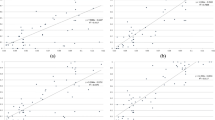Summary
Methods are presented for determining linkage between a marker locus and a nearby locus affecting a quantitative trait (quantitative trait locus=QTL), based on changes in the marker allele frequencies in selection lines derived from the F-2 of a cross between inbred lines, or in the “high” and “low” phenotypic classes of an F-2 or BC population. The power of such trait-based (TB) analyses was evaluated and compared with that of methods for determining linkage based on the mean quantitative trait value of marker genotypes in F-2 or BC populations [marker-based (MB) analyses]. TB analyses can be utilized for marker-QTL linkage determination in situations where the MB analysis is not applicable, including analysis of polygenic resistance traits where only a part of the population survives exposure to the Stressor and analysis of marker-allele frequency changes in selection lines. TB analyses may be a useful alternative to MB analyses when interest is centered on a single quantitative trait only and costs of scoring for markers are high compared with costs of raising and obtaining quantitative trait information on F-2 or BC individuals. In this case, a TB analysis will enable equivalent power to be obtained with fewer individuals scored for the marker, but more individuals scored for the quantitative trait. MB analyses remain the method of choice when more than one quantitative trait is to be analyzed in a given population.
Similar content being viewed by others
References
Becker WA (1967) Manual of procedures in quantitative genetics. In: The program in genetics. Washington State University, Pullman Wash
Beckmann JS, Soller M (1983) Restriction fragment length polymorphisms in genetic improvement: methodologies, mapping and costs. Theor Appl Genet 67:35–43
Beckmann JS, Soller M (1986a) Restriction fragment length polymorphisms and genetic improvement of agricultural species. Euphytica 35:111–124
Beckmann JS, Soller M (1986b) Restriction fragment length polymorphisms in plant genetic improvement. Oxford Surveys of Plant Mol Biol (in press)
Burr B, Evola SV, Burr F, Beckmann JS (1983) The application of restriction fragment length polymorphism to plant breeding. In: Setlow J, Holländer A (eds) Genetic engineering, vol 5. Plenum Press, New York, pp 45–59
Falconer DS (1981) Introduction to quantitative genetics, 2nd edn. Longman, New York
Gutwein E (1976) Isozyme markers in relation to production traits in poultry (in Hebrew, English summary). MSc Thesis, Hebrew University of Jerusalem
Kluge R, Geldermann H (1982) Effects of marked chromosome sections on quantitative traits in the mouse. Theor Appl Genet 62:1–4
Law CN (1966) The location of genetic factors affecting a quantitative character in wheat. Genetics 53:487–498
Patterson FL, Schafer JF, Caldwell RM (1968) Effect of selected linkage blocks on yield and yield components in wheat. In: Finley KW, Shepherd KW (eds) 3rd Int Wheat Genet Symp, Canberra, 5–9 August 1968. Aust Acad Sci, Canberra (distributed by Butterworths)
Soller M, Beckmann JS (1982) Restriction fragment length polymorphisms and genetic improvement. In: 2nd World Congr Genet Appl Livestock Production, vol 6. Madrid, pp 396–404
Soller M, Beckmann JS (1983) Genetic polymorphisms in varietal identification and genetic improvement. Theor Appl Genet 67:25–33
Soller M, Beckmann JS (1985) Restriction fragment length polymorphism and animal genetic improvement. Rev Rural Sci 6:10–18
Soller M, Genizi A, Brody T (1976) On the power of experimental designs for the detection of linkage between marker loci and quantitative loci in crosses between inbred lines. Theor Appl Genet 47:35–39
Soller M, Plotkin-Hazan J (1977) The use of marker alleles for the introgression of linked quantitative alleles. Theor Appl Genet 51:133–137
Spickett SG, Thoday JM (1966) Regular responses to selection. 3. Interaction between located polygenes. Genet Res 7:96–121
Stuber CW, Moll RH, Goodman MM, Schaffer HE, Weir BS (1980) Allozyme frequency changes associated with selection for increased grain yield in maize (Zea mays L.). Genetics 95:225–236
Stuber CW, Goodman MM, Moll RH (1982) Improvement of yield and ear number resulting from selection at allozyme loci in a maize population. Crop Sci 22:737–740
Tanksley SD, Medina-Filho H, Rick CM (1982) Use of naturally occurring enzyme variation to detect and map genes controlling quantitative traits in an interspecific backcross of tomato. Heredity 49:11–25
Tanksley SD, Orton TJ (1983) Isozymes in plant genetics and breeding. Elsevier, Amsterdam
Tanksley SD, Rick CM (1980) Isozyme gene linkage map of the tomato: applications in genetics and breeding. Theor Appl Genet 57:161–170
Thoday JM (1961) Location of polygenes. Nature 191:368–370
Vallejos CE, Tanksley SD (1983) Segregation of isozyme markers and cold tolerance in an interspecific backcross of tomato. Theor Appl Genet 66:241–247
Weller J (1983) Genetic analysis of quantitative traits in Lycopersicon (tomato) by means of genetic markers, including a comparison of an improved cultivar and a wild variety (in Hebrew, English summary). PhD Thesis, Hebrew University of Jerusalem, Israel
Zhuchenko AM, Samovol AP, Korol AB, Andryushchenko AB (1979) Linkage between loci of quantitative characters and marker loci. 2. Influence of three tomato chromosomes on variability of five quantitative characters in backcross progenies. Genetika 15:672–683
Author information
Authors and Affiliations
Additional information
Communicated by E.J. Eisen
Contribution from the ARO, Bet Dagan, Israel. No. 1698-E, 1986 series
Rights and permissions
About this article
Cite this article
Lebowitz, R.J., Soller, M. & Beckmann, J.S. Trait-based analyses for the detection of linkage between marker loci and quantitative trait loci in crosses between inbred lines. Theoret. Appl. Genetics 73, 556–562 (1987). https://doi.org/10.1007/BF00289194
Received:
Accepted:
Issue Date:
DOI: https://doi.org/10.1007/BF00289194




